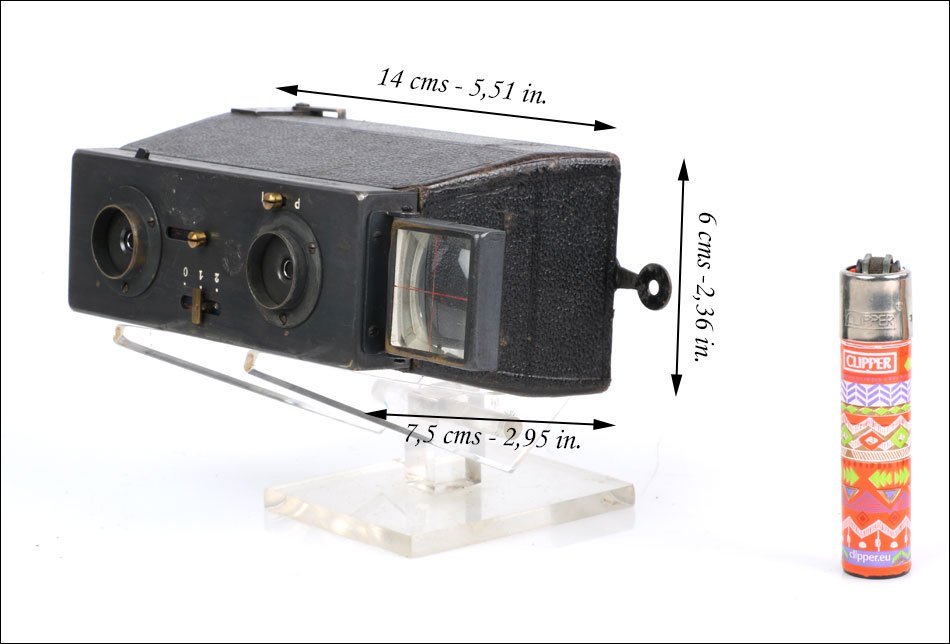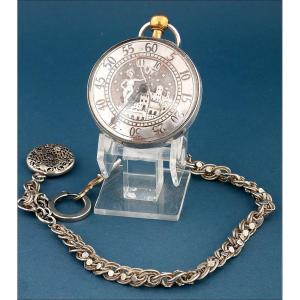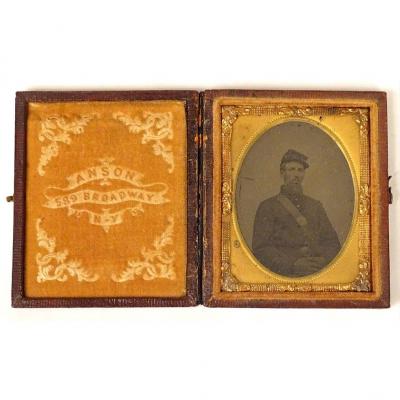The body is constructed of metal covered in grained leather. It shows the expected wear of more than a century of life, but maintains a firm structure, without cracks, without warping and with a very attractive presence. Superficial rubbing can be seen on the covering, especially on the corners and edges, but the camera retains its personality intact, with that dark and elegant tone so characteristic of Richard models from the first decade of the twentieth century.
On the front, the two circular stereoscopic lenses keep their glass clean and the metal plate retains homogeneous aging consistent with its age. The shutter works correctly, an essential point for evaluating the Glyphoscope, as many examples lose the regularity of the mechanism over time.
One of the most notable aspects is that the side folding viewfinder, with its characteristic red grid, is complete and in very good condition; something especially valuable because it is one of the parts most often lost or broken. The image through it is surprisingly clear for its age and its opening and closing system operates without looseness.
The back, which integrates the plate holder, opens and closes with good firmness. The interior shows excellent preservation, with no signs of rust, dents or moisture traces. This allows the system to be used today with plates or adapters, turning it into a camera that is not only collectible, but also usable for experimental stereoscopic photography.
This Jules Richard Le Glyphoscope, manufactured at the key moment of the French stereoscopic boom, is a rare piece, very well preserved and with enormous historical and aesthetic appeal. It is ideal for collectors of stereoscopic cameras, lovers of early twentieth-century photography or anyone who wishes to own an antique camera with a distinctive design that looks fabulous in any cabinet or specialized shelf. A true fragment of European visual history, with irresistible mechanical charm and an exceptional condition for its more than one hundred years.
Measurements: 14 cm (5,51 in) × 6 cm (2,36 in) × 7,5 cm (2,95 in).
History of Jules Richard
The company Jules Richard, founded in Paris, became established in the early twentieth century as the leading reference in accessible stereoscopic photography. One of its greatest contributions was the creation of the 45×107 mm format, a standard that revolutionized the market and enabled the mass production of cameras and viewers designed for amateurs. This format became a social phenomenon: millions of stereoscopic plates circulated throughout Europe, making three-dimensional viewing a domestic entertainment as popular as slides or compact cameras would later become.
The Glyphoscope represented a logical evolution of the successful Verascope, offering a simpler, lighter and more portable body while maintaining the essence of stereoscopic technology. Its jumelle-type design imitated the shape of binoculars, making the camera intuitive and easy to handle. With the rise of tourism and travel at the beginning of the twentieth century, these devices allowed users to capture scenes in 3D with excellent quality, generating personal collections that today are small historical treasures. The Jules Richard firm continued to produce cameras, viewers and accessories for decades, leaving an immense legacy within European analog photography. We are professional antique dealers. To see more photos of this item, Please click on this link:
https://www.antiguedades.es/en/antique-cameras/5372-antique-jules-richard-le-glyphoscope-stereoscopic-camera-45x107-france-c1905.html














































 Le Magazine de PROANTIC
Le Magazine de PROANTIC TRÉSORS Magazine
TRÉSORS Magazine Rivista Artiquariato
Rivista Artiquariato